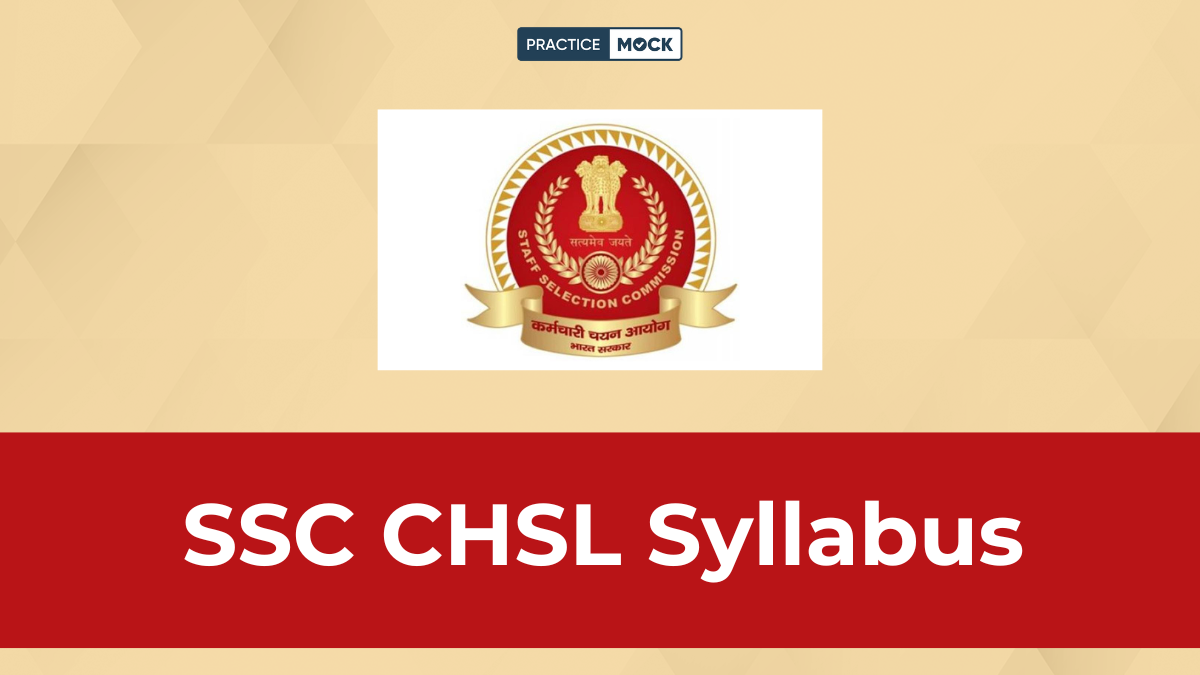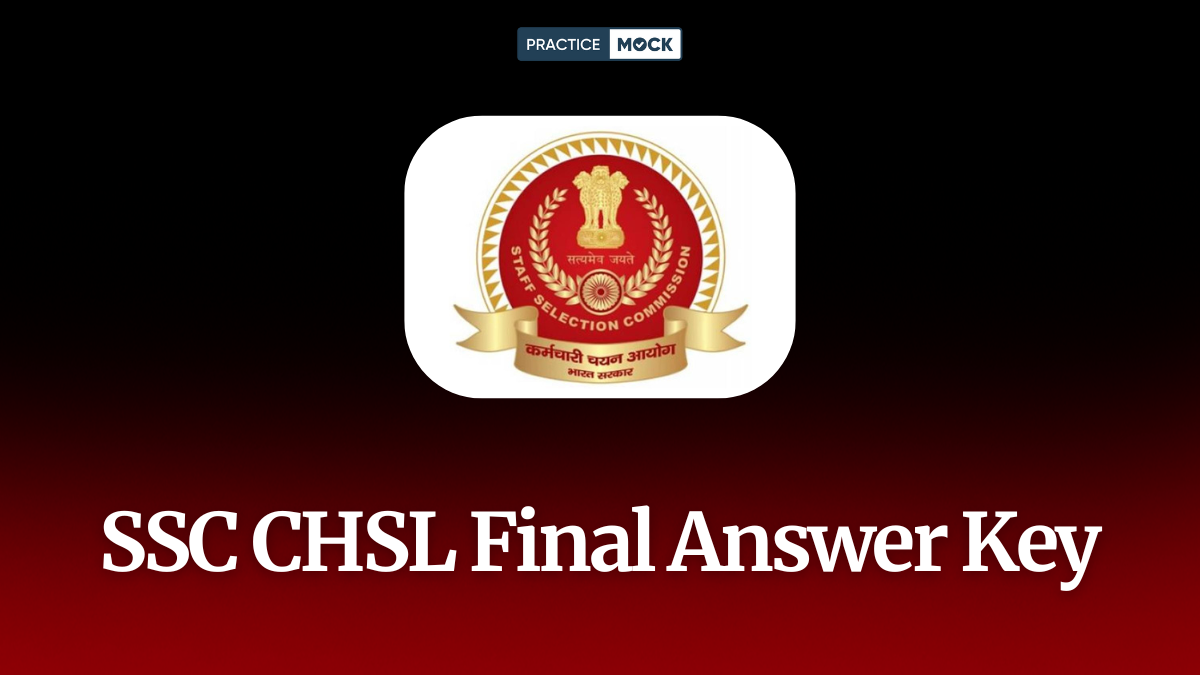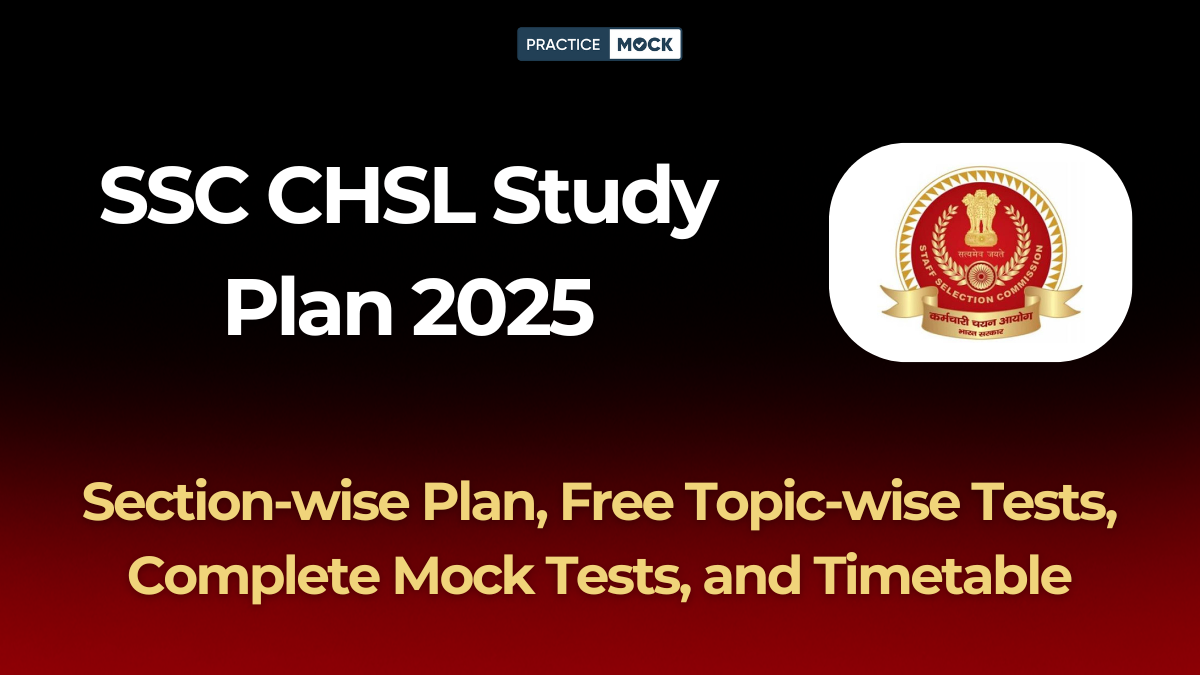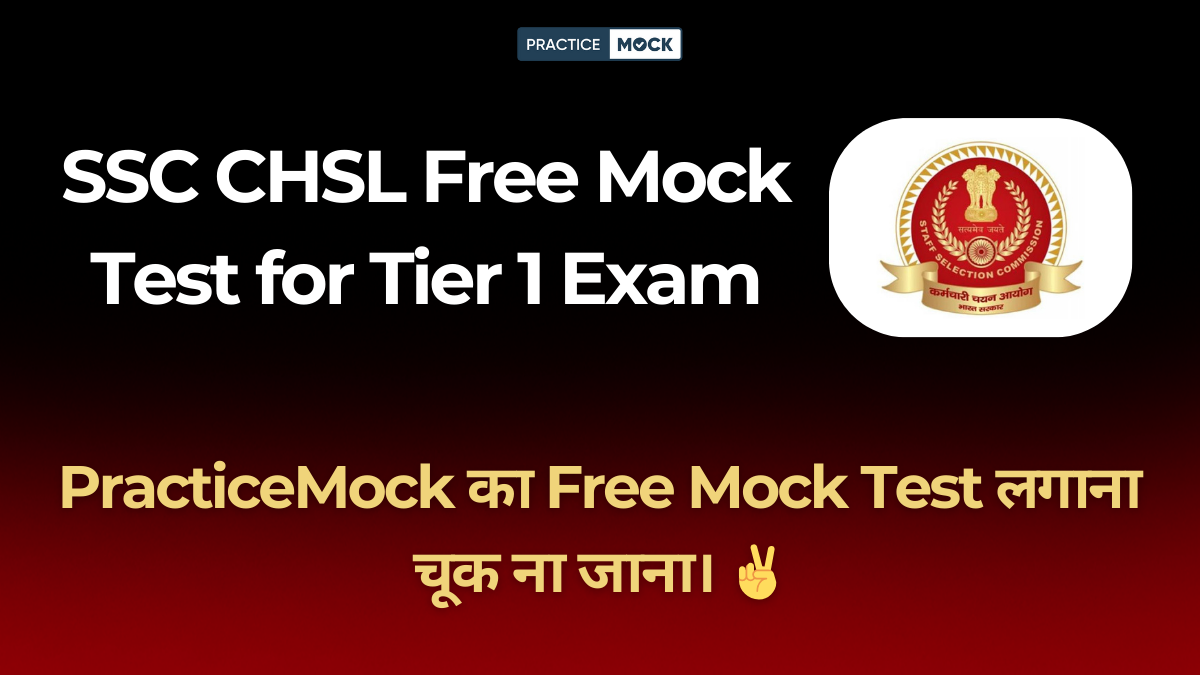SSC CHSL Syllabus 2025, Download Free PDF for Topic-wise Weightage


SSC CHSL Syllabus 2025: The Staff Selection Commission (SSC) conducts the SSC CHSL Exam to recruit candidates for the LDC, DEO, and Junior Secretariat Assistant posts. In this blog, we have provided the SSC CHSL Syllabus 2025 for Tier 1 and Tier 2 exams. Knowing and analyzing the SSC CHSL Syllabus is very important for candidates before starting their exam preparation. With the help of the syllabus, you will be able to create a study plan, a preparation strategy, and many more things. The SSC CHSL Syllabus 2025 mainly consists of sections such as General Intelligence, General Awareness, Quantitative Aptitude & English Language. So, read this blog carefully and analyze the syllabus.
SSC CHSL Syllabus 2025 Summary
The SSC CHSL Syllabus 2025 summary is provided below in a table format including the selection process, sections including tier 1 and tier 2, and much more for the candidate’s convenience. Read the table carefully to know all the details.
| SSC CHSL Syllabus 2025 Summary | |
| Name of Conducting Body | Staff Selection Commission (SSC) |
| Exam Name | SSC CHSL |
| Post Name | LDC, DEO, and Junior Secretariat Assistant |
| Selection Process | Tier 1, Tier 2 + Typing Test/Skill Test |
| SSC CHSL Syllabus 2025 Tier 1 Subjects | General Intelligence, General Awareness, Quantitative Aptitude & English Language |
| SSC CHSL Syllabus 2025 Tier 2 Subjects | Section 1, Module I: Mathematical Abilities and Module II: Reasoning and General Intelligence Section 2, Module I: English Language and Comprehension and Module II: General Awareness Section 3, Module I: Computer Knowledge Test and Module II: Skill Test/ Typing Test |
| Negative Marking | Tier 1: 0.5 Mark & Tier 2: 1 Mark. |
| SSC Official Website | www.ssc.gov.in |
SSC CHSL Syllabus 2025 for Tier 1 Exam
The SSC CHSL Tier 1 exam consists of four sections. Below we have provided the detailed SSC CHSL Syllabus 2025 for Tier 1 exam for all the sections. Candidates should thoroughly prepare with the Syllabus for Tier 1 to increase their chances of success.
- General Intelligence and Reasoning
- General Awareness
- Quantitative Aptitude
- English Comprehension
SSC CHSL Syllabus 2025 Reasoning
Check out the SSC CHSL Reasoning Syllabus provided below in a table format. It includes both verbal and non-verbal reasoning.
- Classification
- Analogy
- Coding-Decoding
- Paper Folding Method
- Matrix
- Word Formation
- Venn Diagram
- Direction and Distance
- Blood Relations
- Verbal Reasoning
- Non-Verbal Reasoning
- Seating Arrangement
- Puzzle
- Series
SSC CHSL General Awareness Syllabus
The SSC CHSL General Awareness syllabus consists of the knowledge of current affairs and the general knowledge of Indian history, constitution, geography, etc of the candidates. Stay updated with the current affairs if you want to excel in your preparation in this section.
- Static General Knowledge
- Science
- Current Affairs
- Sports
- Books and Authors
- Important Schemes
- Portfolios
- People in the News
- History
- Culture
- Geography
- Economics
- Awards and Honors
SSC CHSL Quantitative Aptitude Syllabus
The SSC CHSL Quantitative Aptitude Syllabus includes topics from basic and advanced mathematics. Practice as much as possible, if you want to cover this section in the exam timely.
- Simplification
- Interest
- Averages
- Percentage
- Ratio and Proportion
- Problem on Ages
- Speed, Distance, and Time
- Number System
- Mensuration
- Data Interpretation
- Time and Work
- Algebra
- Trigonometry
- Geometry
SSC CHSL English Comprehension Syllabus
Here we have provided the SSC CHSL English Comprehension syllabus for the Tier 1 exam. The English section tests candidates’ knowledge of English Comprehension and Grammar.
- Reading Comprehension
- Cloze Test
- Spellings
- Phrases and Idioms
- One Word Substitution
- Sentence Correction
- Error Spotting
- Fill in the Blanks
- Para Jumbles
- Active/Passive
- Narration
SSC CHSL Topic-wise Weightage, Download Free PDF
As we all know, the preparation of the SSC CHSL exam requires a strategy or a plan. In this blog, we have provided the detailed SSC CHSL Syllabus 2025 with the help of it you can make your own study plan and categorize the topics into weak and strong areas according to your preference. Knowing the SSC CHSL topic-wise weightage can help you categorize the topics into highest scoring, and low scoring easily. So for your convenience, we have provided a free PDF below that contains the SSC CHSL topic-wise weightage and detailed syllabus too.
SSC CHSL Syllabus 2025 for Tier 2 Exam
The SSC CHSL Syllabus 2025 for Tier 2 exam is divided into modules and modules are further divided into sessions. Below we have provided the detailed SSC CHSL Tier 2 syllabus module-wise.
Module-I of Session-I (Mathematical Abilities)
Check out the detailed mathematical abilities syllabus for the tier 2 exam.
| Subject | Topics |
| Number Systems | – Number Systems – Computation of Whole Numbers – Decimal and Fractions – Relationship Between Numbers |
| Arithmetic | – Percentages – Ratio and Proportion – Square Roots – Averages – Interest (Simple and Compound) – Profit and Loss – Discount – Partnership Business – Time and Distance – Time and Work |
| Algebra | – Basic Algebraic Identities – Elementary Surds – Graphs of Linear Equations |
| Geometry | – Elementary Geometric Figures – Triangles – Congruence and Similarity of Triangles – Circle and Their Properties – Tangents – Angles Subtended by Chords – Common Tangents to Circles |
| Mensuration | – Triangle – Quadrilaterals – Regular Polygons – Circle – Right Prism – Right Circular Cone – Right Circular Cylinder – Sphere – Hemispheres – Rectangular Parallelepiped – Regular Right Pyramid with Triangular or Square Base |
| Trigonometry | – Trigonometric Ratios – Complementary Angles – Height and Distances – Standard Identities |
| Statistics & Probability | – Use of Tables and Graphs – Histogram – Frequency Polygon – Bar-Diagram – Pie-Chart – Measures of Central Tendency (Mean, Median, Mode) – Standard Deviation – Calculation of Simple Probabilities |
Module II of Section I (Reasoning and General Intelligence)
The general intelligence and reasoning syllabus for the tier 2 exam is provided below. The SSC asks questions from this section to test the candidates thinking and logical abilities.
- Semantic Analogy
- Symbolic operations
- Symbolic/Number Analogy
- Venn Diagrams
- Drawing inferences
- Punched hole/folding
- Embedded figures
- Critical Thinking
- Word Building
- Numerical operations
- Trends
- Figural Analogy
- Space Orientation
- Semantic Classification
- Symbolic/Number Classification
- Figural Classification
- Semantic Series
- Number/Figural Series
- Problem-Solving/Emotional Intelligence
- Social Intelligence/Coding
Module-I of Section II (English Language And Comprehension)
Check out the English Language And Comprehension syllabus for the tier 2 exam. This is to check the basic English language understanding of the candidates.
- Vocabulary
- Grammar
- Sentence structure
- Fill in the Blanks
- Idioms & Phrases
- Improvement of Sentences
- Direct/Indirect Narration
- Passage Analysis
- Comprehension Passage
- Synonyms/Homonyms
- Antonyms
- Spot the Error
- Spellings/Mis-spelt words
- One-word Substitution
- Active/Passive Voice
- Sentence Shuffling
- Cloze Passage
Module II of Section II (General Awareness)
Stay updated with current affairs. As per the expert suggestions, you must be updated with at least 6 months of current affairs. Make a study plan or timetable which consists of regular revision, and study.
- History
- Culture
- Geography
- Economic Scene
- General Policy
- Scientific Research
- Current Events
- India and its Neighbours
Module-I of Section-III of Paper-I: Computer Proficiency
Computer Basics
- Organization of a computer
- Central Processing Unit (CPU)
- Input/ Output devices
- computer memory
- memory organization
- backup devices
- PORTs
- Windows Explorer
- Keyboard shortcuts
Windows Operating system including basics of Microsoft Office like:
- MS Word
- MS Excel
- PowerPoint
Working with the Internet and e-mails
- Web Browsing & Searching
- Downloading & Uploading
- Managing an E-mail Account
- e-banking.
Basics of networking and cyber security
Networking devices and protocols, Network and information security threats (like hacking, viruses, worms, Trojans, etc.), and preventive measures.
SSC CHSL Minimum Qualifying Marks
Below we have provided the SSC CHSL minimum qualifying marks for Tier-I, Section-I, Section-II, and Module-I of Section-III in the Tier-II Examination. Check the category-wise minimum qualifying marks.
| SSC CHSL Minimum Qualifying Marks | |
| Category | Percentage |
| UR | 30% |
| OBC/EWS | 25% |
| All other categories | 20% |
SSC CHSL 2025 Skill Test
The SSC conducts the SSC CHSL Skill Test or typing test during session II on the same day. Below we have provided the details such as the medium of typing test, required speed, test duration, key depressions per hour, and much more in a table format.
| Position | Medium of Typing Test | Required Speed | Test Duration | Key Depressions per Hour |
|---|---|---|---|---|
| Data Entry Operator | N/A | 8,000 key depressions per hour | 15 minutes | 2,000 – 2,200 key depressions |
| Data Entry Operator Grade A | N/A | 15,000 key depressions per hour | 15 minutes | 3,700 – 4,000 key depressions |
| LDC / JSA | Hindi or English | 35 w.p.m. (English) | 10 minutes | 10,500 key depressions |
| Postal Assistant / Sorting Assistant | Hindi or English | 30 w.p.m. (Hindi) | 10 minutes | 9,000 key depressions |
| Other Related Article SSC CHSL | |
| SSC CHSL Exam Pattern | SSC CHSL Study Plan |
| SSC CHSL Previous Year Question Paper | SSC CHSL Salary |
| SSC CHSL Cut Off | SSC Selection Process |
SSC CHSL Syllabus 2025 FAQs
Read our blog carefully to learn about the SSC CHSL Syllabus.
The SSC CHSL (Combined Higher Secondary Level) exam is conducted by the Staff Selection Commission to recruit candidates for posts like LDC, DEO, and Junior Secretariat Assistant.
The main sections in Tier 1 are General Intelligence, General Awareness, Quantitative Aptitude, and English Comprehension.
Yes, there is a negative marking of 0.5 marks for each incorrect answer in Tier 1.
Topics include current affairs, static general knowledge, science, history, culture, geography, and important schemes.
Key topics include simplification, percentage, average, ratio and proportion, algebra, trigonometry, and data interpretation.
Recent Posts
IBPS Clerk Free Study Material 2025, Check All Resources
Here we are providing the IBPS Clerk Free Study Material 2025, Candidates can check IBPS…
Is RBI Grade A Better than NABARD Grade A?
RBI or NABARD, which Grade A job suits your personality and passion? Find detailed comparisons…
SSC CGL English Free Topic-wise Tests, Get Direct Links
In this blog, we have provided the SSC CGL English Free Topic-wise Tests. This will…
Simplification Tricks For IBPS RRB PO 2025 Exam, Download Questions PDF
Here we are providing the Simplification Tips & Tricks For IBPS RRB PO 2025 Exam.…
RRB NTPC Reasoning Preparation Strategy 2025, Free Resources
In this blog, we have provided the RRB NTPC Reasoning Preparation Strategy 2025. Also attempt…
SSC CGL Reasoning Free Topic-wise Tests, Get Direct Links
In this blog, we have provided the SSC CGL Reasoning Free Topic-wise Tests. This will…



